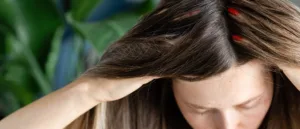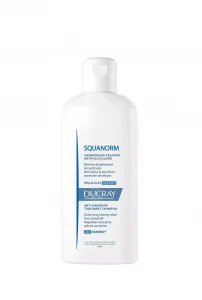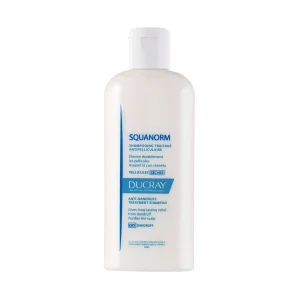
As anyone with dandruff knows, it can be embarrassing to wear black tops when they are covered in unsightly white flakes. Once you figure out what irritates your scalp enough to cause dandruff, you can treat it much more easily. That’s why, in this article from The Dermo Lab, we’re going to break down the reasons for dandruff and what to do about it with the dermatologist Dr. Ahmed Rihan.
What are the reasons for excessive dandruff?
According to Dr. Ahmed Rihan, here are the causes of dandruff:
- Irritated and oily skin
- A yeast-like fungus (Malassezia): Dr. Ahmed Rihan explains that Malassezia furfur is a fungus belonging to the physiological flora of the skin that feeds on the oils present on the scalp of most adults.
- Sensitivity to hair care products (contact dermatitis)
- Common skin conditions such as psoriasis and eczema.
Dr. Ahmed Rihan adds that stress can aggravate or increase dandruff in susceptible individuals. Malassezia cannot be introduced into your scalp by stress, but it can be increased if your immune system is compromised or suppressed.
What are the habits that cause dandruff?
According to Dr. Ahmed Rihan, certain habits cause dandruff such as:
- Not brushing your hair properly
- Leaving your hair greasy
- Not fighting fungus by not using the right shampoo
- Heat and various chemicals applied to the hair when styling
- Vitamin B deficiency
- Frequent washing of hair with hot water. Dr. Ahmed Rihan explains that this can lead to a dry scalp which can become irritated and increase skin cell loss.
“Foods rich in vitamin E and omega 3 are beneficial, and a good protein-rich diet is beneficial. Biotin, magnesium, and potassium are also essential,” adds Dr. Ahmed Rihan.
What are some surprising facts about dandruff?
Here are all the facts and myths about dandruff: (1)
1- Regular hair washing eliminates dandruff
FALSE. Dandruff is not a hygiene problem. Simply washing your hair is not enough to get rid of it. You must use an anti-dandruff shampoo formulated to reduce the presence of Malassezias and epidermal proliferation.
2- Dandruff only gets worse
FALSE. Dandruff is generally stable and, in practice, can be controlled with effective anti-dandruff shampoos. These shampoos should be used regularly.
3- Dandruff is hereditary
FALSE. Dandruff is essentially linked to an increase in epidermal proliferation and the presence of Malassezias. No genetic factor has been identified to date.
4- Dandruff is contagious
FALSE: Remember those days at school when you kept your distance from people who had dandruff that you thought was contagious? Although dandruff may scare you, it is far from contagious or infectious. This means you can take the idea of having a flaky, irritated, swollen scalp from a loved one off your list.
5- Dandruff gets worse in summer
FALSE. No seasonal or sun-related factors contribute to the increase in dandruff.
6- Smoking increases dandruff
FALSE. Smoking has several negative effects on your health, including the health of your skin. However, dandruff is not one of them.
7- Dandruff is long-lasting
TRUE. It is a chronic increase in flaking, linked to the colonization of the skin by Malassezia. These yeasts are naturally present on the skin. Effective treatment can eliminate dandruff. However, when the treatment is stopped, dandruff reappears after a relatively long period of time.
8- Dandruff is caused by diet
FALSE. Your diet does not influence seborrhea or the condition of dandruff. However, in the general interest of good health, it is preferable to maintain a healthy diet and eat fruits and vegetables rather than foods containing excess fat and sugar.
9- Any shampoo can get dandruff out of your hair
FALSE: Are you one of those people who is constantly switching from one shampoo to another wondering which one would be ideal for your hair? If so, you should stop looking! While it’s true that some shampoos can help you get rid of dandruff, anti-dandruff shampoos are the only ones that can provide the best results for dandruff removal. Anti-dandruff shampoos are designed to get rid of dandruff on your scalp.
What are the best shampoo ingredients for treating dandruff?
To reduce the buildup of oil and skin cells, wash your hair daily with a mild shampoo, gently massaging the scalp to loosen dandruff. (2)
Products containing zinc pyrithione are popular for treating dandruff because they contain antibacterial and antifungal properties. We also recommend charcoal shampoos (to slow skin cell growth), selenium sulfide shampoos (to slow skin cell growth and reduce Malassezia), and salicylic acid (to exfoliate the scalp). (3)
Since no hair solution can cure your dandruff right away, it’s a good idea to switch up your product every now and then to keep your flakes at bay. (3) It’s a good idea to alternate between different ingredients and not use the same ones all the time. (4)
Our top picks:
For oily dandruff:
Ducray Squanorm Anti-Dandruff Treatment Shampoo – Oily Dandruff
For dry dandruff:
Ducray Squanorm Anti-Dandruff Treatment Shampoo – Dry Dandruff
What are some additional approaches to treating dandruff?
- Get some sun. Brief exposure to the sun can help reduce yeast production on the scalp. (5) But if you also use a tar-based dandruff treatment, avoid direct sun exposure, as your scalp is susceptible to sunlight. (6)
- Reduce your use of hair products. Styling gels, sprays, ointments, and other products can build up on the hair and scalp, increasing sebum production and dandruff.
- Manage stress.
- Don’t forget to clean your comb and your brush to remove oil.
How many people have dandruff?
According to previous research, dandruff affects approximately 50% of the general adult population worldwide. Dandruff is more common in men than in women (7).
The bottom line
While dandruff can be a difficult problem to manage, various remedies can reduce symptoms and provide relief.
The next time you start to experience dandruff, try the products above to promote scalp health and reduce dandruff. You no longer have to worry about flurries falling out of your hair!
If these remedies don’t work, consult a dermatologist to see if other treatment options are needed for lasting relief.











